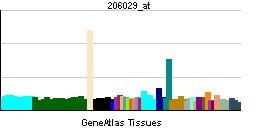Entrez 27063 | Ensembl ENSG00000148677 | |
 | ||
Aliases ANKRD1, ALRP, C-193, CARP, CVARP, MCARP, bA320F15.2, ankyrin repeat domain 1 External IDs MGI: 1097717 HomoloGene: 8289 GeneCards: ANKRD1 | ||
CARP, also known as Cardiac adriamycin-responsive protein or Cardiac ankyrin repeat protein is a protein that in humans is encoded by the ANKRD1 gene. CARP is highly expressed in cardiac and skeletal muscle, and is a transcription factor involved in development and under conditions of stress. CARP has been implicated in several diseases, including dilated cardiomyopathy, hypertrophic cardiomyopathy, and several skeletal muscle myopathies.
Contents
Structure
Human CARP is a 36.2kDa protein composed of 319 amino acids., though in cardiomyocytes, CARP can exist as multiple alternatively spliced forms. CARP contains five tandem ankyrin repeats. Studies have shown that CARP can homodimerize. Studies have also shown that CARP is N-terminally, post-translationally cleaved by calpain-3 in skeletal muscle, suggesting alternate bioactive forms of CARP exist. CARP has been localized to nuclei and Z-discs in animal and human myocytes, and at intercalated discs in human cells.
Function
CARP was originally identified as a YB-1-associating, cardiac-restricted transcription co-repressor in the homeobox NKX2-5 pathway that is involved in cardiac ventricular chamber specification, maturation and morphogenesis, and whose mRNA levels are exquisitely sensitive to Doxorubicin, mediated through a hydrogen peroxide/ERK/p38MAP kinase-dependent as well as M-CAT cis-element-dependent mechanism. Subsequent studies showed that CARP expression in cardiomyocytes is regulated by alpha-adrenergic signaling, in part via the transcription factor GATA4. An additional study showed that beta-adrenergic signaling via protein kinase A and CaM kinase induces the expression of CARP, and that CARP may have a negative effect on contractile function. CARP has also been identified as a transcriptional co-activator of tumor suppressor protein p53 for stimulating gene expression in muscle; p53 was found to be an upstream effector of CARP via upregulation of the proximal ANKRD1 promoter. Interestingly, CARP protein has a relatively short half-life being longer in cardiomyocytes than endothelial cells; and CARP is degraded by the 26S proteasome via a PEST degron.
In animal models of disease and injury, CARP has been characterized to be a stress-inducible myofibrillar protein. CARP has been shown to play a role in skeletal muscle structure remodeling, and repair, being expressed in skeletal muscle near myotendinous junctions, and in vascular smooth muscle cells, as a downstream target of TGF-beta/Smad sigmaling in response to balloon injury and atherosclerotic plaques. Further studies have identified a role for CARP in initiation and regulation of arteriogenesis. Decreased expression of CARP in cardiac cells within the ischemic region was detected in a rat model of ischemic injury, and was thought to be linked to the induction of GADD153, an apoptosis-related gene. In cardiomyocytes treated with doxorubicin, a model of anthracycline-induced cardiomyopathy, CARP mRNA and protein levels were depleted, myofilament gene transcription was attenuated and sarcomeres showed significant disarray.
In a transgenic mouse model of cardiac-specific overexpression of CARP, mice exhibited normal physiology at baseline, but were protected against pathological cardiac hypertrophy induced via pressure-overload or isoproterenol, which could be attributed to the downregulation of the ERK1/2, MEK and TGFbeta-1 pathways. Another study demonstrated that adenoviral overexpression of CARP in cardiomyocytes enhances cardiac hypertrophy induced by Angiotensin II or pressure-overload and promotoes cardiomyocyte apoptosis via p53 activation and mitochondrial dysfunction. However, transgenic knockout models of either CARP alone or CARP in combination with the other muscle ankyrin repeat proteins (MARPs), ANKRD2 and ANKRD23 demonstrated a lack of cardiac phenotype; mice displayed normal cardiac function at baseline and in response to pressure overload-induced cardiac hypertrophy, suggesting that these proteins are not essential.
Interactions between CARP and the sarcomeric proteins myopalladin and titin suggest that it may also be involved in the myofibrillar stretch-sensor system. Passive stretch in fetal cardiomyocytes induced differential CARP distribution at nuclei and I-band titin N2A regions. In a mouse model of muscular dystrophy with myositis (mdm) caused by a small deletion in titin, CARP mRNA expression was shown to be 30-fold elevated in skeletal muscle tissue.
Clinical significance
A wide spectrum of clinical features have been associated with ANKRD1/CARP protein. Mutations in ANKRD1 have been associated with dilated cardiomyopathy, two of which result in altered binding with TLN1 and FHL2. Mutations in ANKRD1 have also been associated with hypertrophic cardiomyopathy, and have shown to increase binding of CARP to Titin and MYPN. Examination of the functional effects of CARP hypertrophic cardiomyopathy mutations in engineered heart tissue demonstrated that Thr123Met was a gain-of-function mutation exhibiting augmented contractile properties; whereas Pro52Ala and Ile280Val were unstable and failed to incorporate into sarcomeres, an effect that was remedied upon proteasome inhibition via epoxomicin.
A missense mutation in ANKRD1 was shown to be associated with the congenital heart defect, Anomalous pulmonary venous connection. CARP has been found as a sensitive and specific biomarker for the differential diagnosis of rhabdomyosarcoma. Interestingly, ANKRD1 mRNA levels correlate with patient platinum sensitivity, thus ANKRD1 associates with platinum-based chemotherapy treatment outcome in ovarian adenocarcinoma patients.
CARP protein and mRNA expression has been shown to be upregulated in left ventricles of heart failure patients. Studies in patients with amyotrophic lateral sclerosis, spinal muscular atrophy, and congenital myopathy, also found altered expression of CARP in skeletal muscle fibers. Another study in congenital muscular dystrophy and Duchenne muscular dystrophy patients showed elevated expression of CARP. CARP expression is also elevated in patients with lupus nephritis, and associates with proteinuria severity, suggesting that it may have biomarker potential.
Interactions
ANKRD1 has been shown to interact with:
